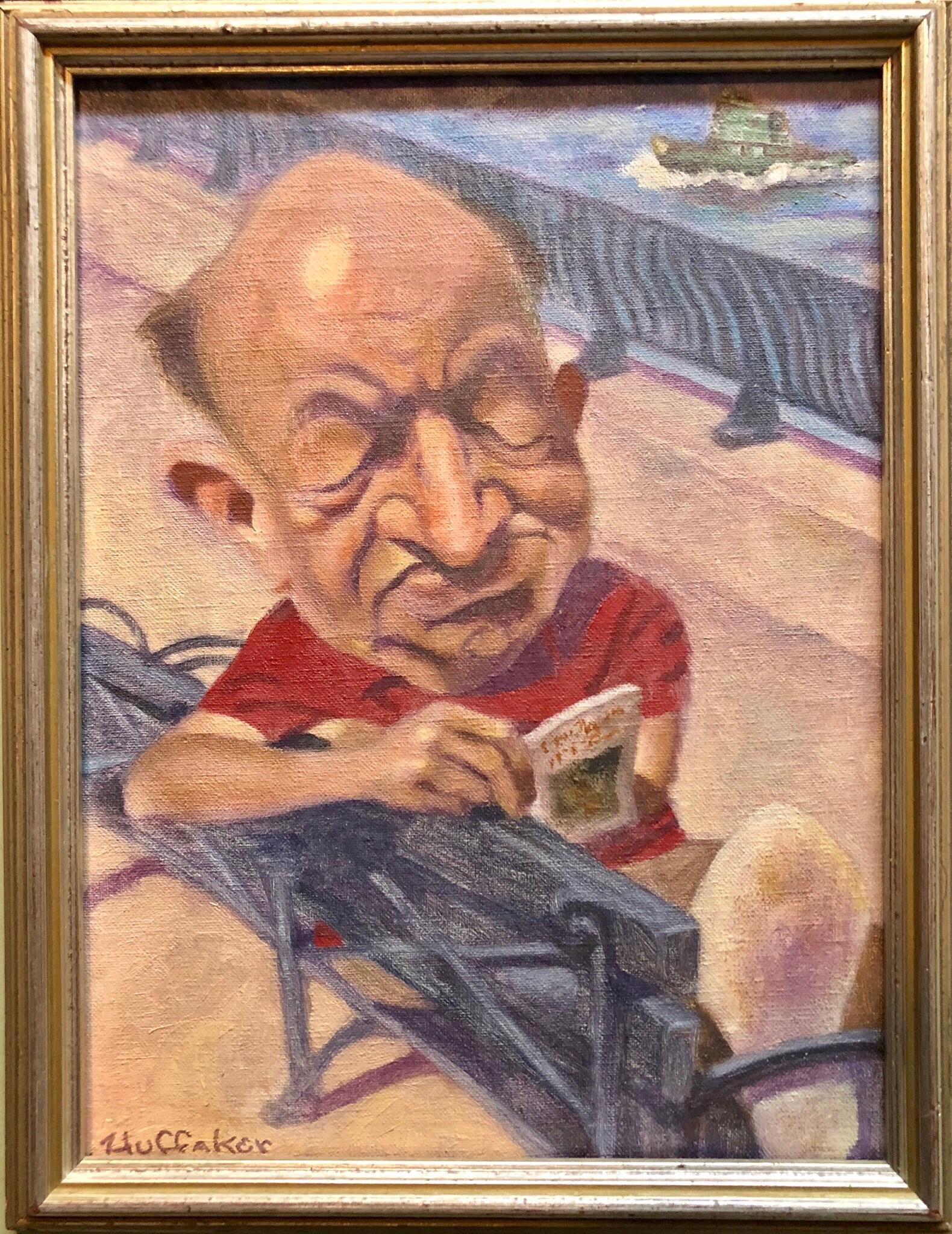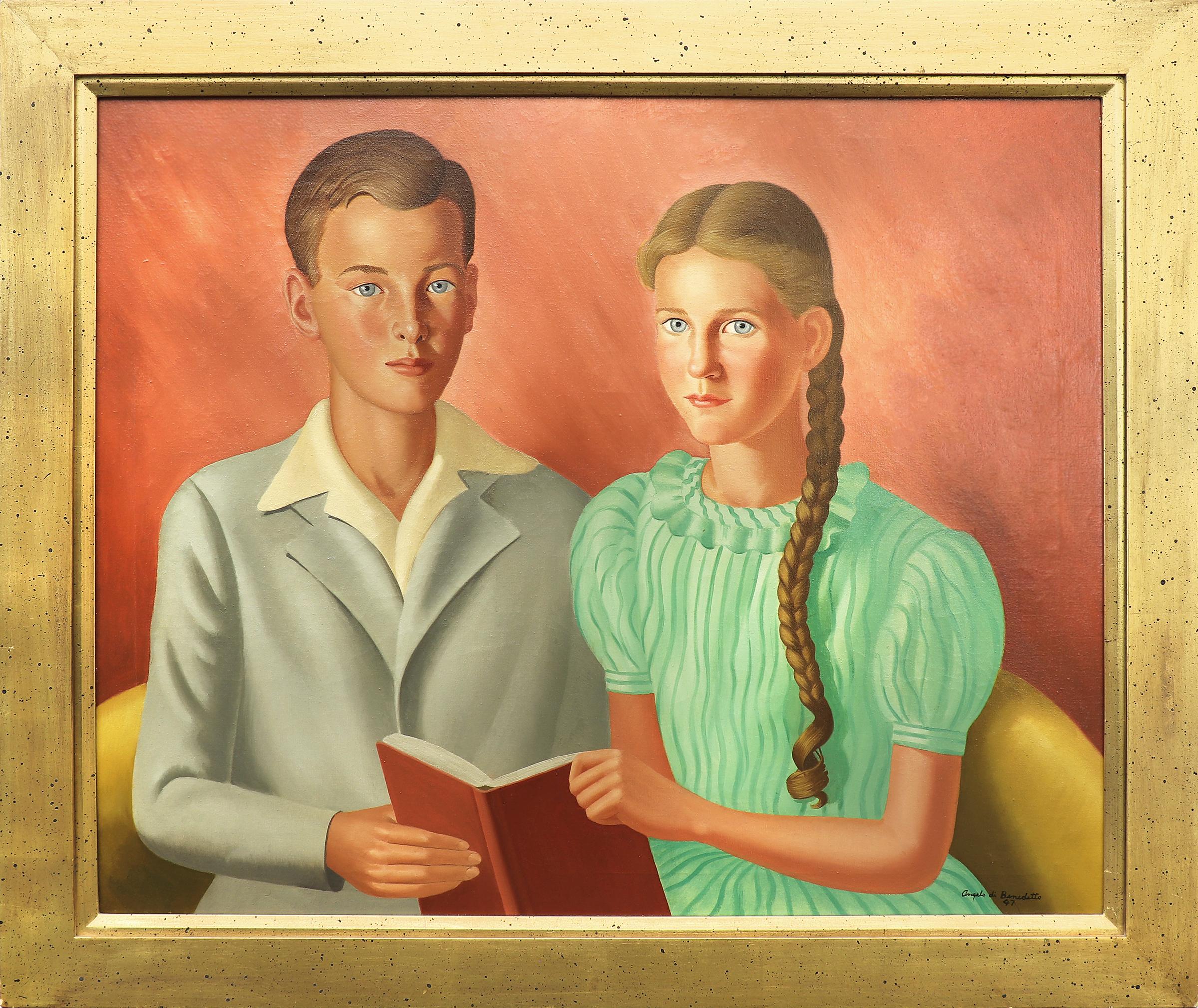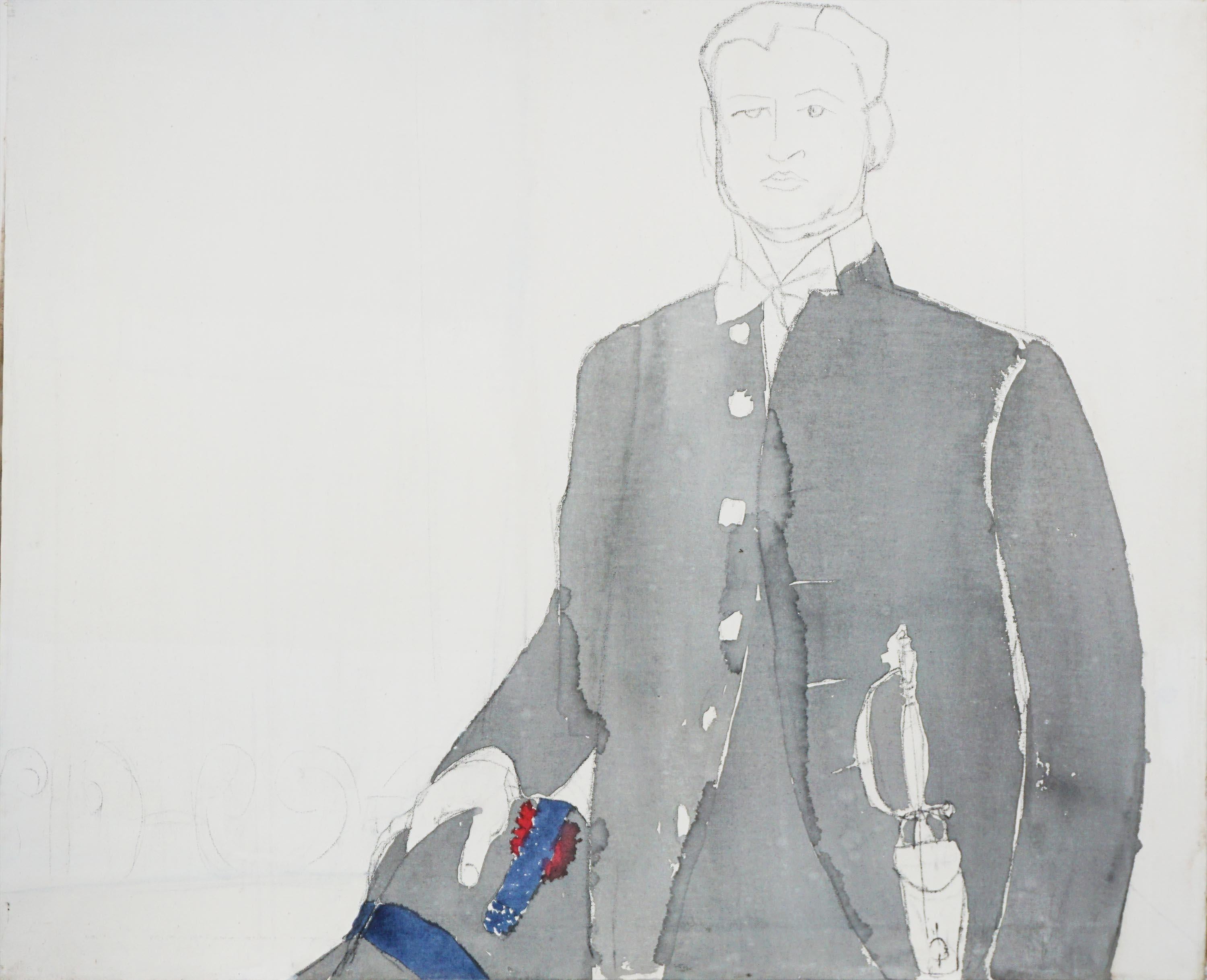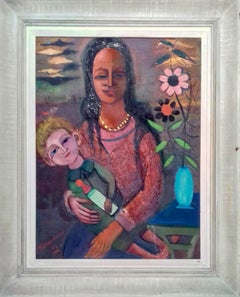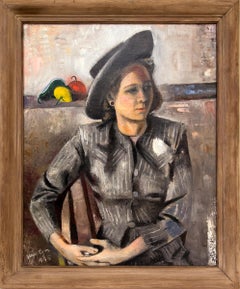Carmen Miranda Latin American Modernism Hollywood Portrait Mid 20th Century WPA
View Similar Items
Want more images or videos?
Request additional images or videos from the seller
1 of 9
Paul MeltsnerCarmen Miranda Latin American Modernism Hollywood Portrait Mid 20th Century WPA 1942
1942
About the Item
- Creator:Paul Meltsner (1905 - 1966, American)
- Creation Year:1942
- Dimensions:Height: 48 in (121.92 cm)Width: 42 in (106.68 cm)Depth: 3 in (7.62 cm)
- Medium:
- Movement & Style:
- Period:
- Condition:
- Gallery Location:New York, NY
- Reference Number:1stDibs: LU115629027952
About the Seller
5.0
Platinum Seller
These expertly vetted sellers are 1stDibs' most experienced sellers and are rated highest by our customers.
Established in 2008
1stDibs seller since 2019
165 sales on 1stDibs
More From This SellerView All
- "Unemployed" WPA American Scene Social Realism Mid 20th Century ModernBy William GropperLocated in New York, NY"Unemployed" WPA American Scene Social Realism Mid 20th Century Modern William Gropper (1898 - 1977) Unemployed 20 x 16 inches Oil on canvas, 1937 Signed lower right Provenance: E...Category
1930s American Realist Figurative Paintings
MaterialsCanvas, Oil
$20,000 Sale Price20% Off - Post Office WPA Mural Study American Scene Social Realism Modern 20th CenturyBy Carlos LopezLocated in New York, NYPost Office WPA Mural Study American Scene Social Realism Modern 20th Century Carlos Lopez (1910-1953) "Bounty" WPA Mural Study for Michigan Post Office 19 ½ x 22 ½ inches Oil on B...Category
1940s American Realist Figurative Paintings
MaterialsBoard, Oil
- "Sock Hop" Mid-Century American Modernism WPA Female Artist 20th Century RealismBy Kyra MarkhamLocated in New York, NY"Sock Hop" Mid-Century American Modernism WPA Female Artist 20th Century Realism. 30 x 24 inches. Oil on canvas. Signed on stretcher, c. 1940s. Frame is likely original to the painting. Realist painter-printmaker Kyra Markham...Category
1940s American Modern Figurative Paintings
MaterialsOil, Canvas
- Till the Clouds Roll By 1945 Frank Sinatra Mid Century Modern Hollywood Film WPABy Richard WhorfLocated in New York, NYTill the Clouds Roll By 1945 Frank Sinatra Mid Century Modern Hollywood Film WPA TILL THE COULDS ROLL BY (Film Set), oil on canvas, 20 x 24 inches signed “Richard Whorf” lower right and signed and dated on the verso “R. Whorf/ Dec. 21, 1945. Frame by Hendenryk. ABOUT THE PAINTING This painting is from the collection of Barbara and Frank Sinatra, dated December 21, 1945 (just nine days after Frank Sinatra’s 30th birthday), and depicts the Metro-Goldwyn-Mayer Culver City backlot during the filming of Till the Clouds Roll By, the direction of the film having been taking over by Richard Whorf in December 1945. It is not presently clear if Whorf gave the Sinatras this painting as a gift, as the presence of the Dalzell Hatfield Galleries label on the verso indicates the painting may have been sourced there. Frank and Nancy Sinatra acquired a number of works from Dalzell Hatfield Galleries during the 1940’s, or perhaps they framed it for the couple. Sinatra performed “Old Man River’ in the film. Sinatra and June Allyson are depicted in the center of the painting. PROVENANCE From the Estate of Mrs. Nancy Sinatra; Dalzell Hatfield Galleries, Ambassador Hotel, Los Angeles. An image of the Dalzell Hatfield label and the back of the original frame (which we replaced with a stunning Heydenrk frame) are attached. Nancy Sinatra was Fran's first wife. Nancy Rose Barbato was 17 years old when she met Frank Sinatra, an 18-year-old singer from Hoboken, on the Jersey Shore in the summer of 1934. They married in 1939 at Our Lady of Sorrows Church in Jersey City where Frank gave Nancy a recording of a song dedicated to her titled "Our Love" as a wedding present. The young newlyweds lived and worked in New Jersey, where Frank worked as an unknown singing waiter and master of ceremonies at the Rustic Cabin while Nancy worked as a secretary at the American Type Founders. His musical career took off after singing with big band leaders Harry James and Tommy Dorsey...Category
1940s American Modern Landscape Paintings
MaterialsCanvas, Oil
- Industrial Mid-20th Century WPA Modern Men Working American Scene Social RealismLocated in New York, NYIndustrial Mid-20th Century WPA Modern Men Working American Scene Social Realism George Pearse Ennis (American, 1884-1936) "Forging a Gun Tube #1...Category
1910s American Modern Interior Paintings
MaterialsCanvas, Oil
- NYC 1939 World's Fair Mural Study American Scene WPA Modern Mid 20th CenturyLocated in New York, NYNYC 1939 World's Fair Mural Study American Scene WPA Modern Mid 20th Century Eugene Savage (1883 – 1978) 1939 World’s Fair Mural Study 45 x 30 inches Oil on Canvas Signed lower right The painting is part of a 1,000 piece collection of art and objects from the 1939 World’s Fair. The collection as a whole is available. Savage created the mural for the facade of the Communications Building. An image of the completed mural, along with a published postcard, is part of the listing. Note the center top female figure, she resembles the figure in the offered painting. BIO Eugene Francis Savage was born in Covington, Indiana 1883. He underwent various forms of art training in the early years. He was a pupil of The Corcoran Gallery and The Art Institute of Chicago, and was later awarded a fellowship to study in Rome at The American Academy. While under the spell of that ancient city the young artist began to render historic figures that were suitable for the classic style needed for mural painting in the traditional manor. During this period he was able to study and observe Roman and Greek sculpture, although much of the academic training was accomplished by using plaster casts along with the incorporation of live models. This method survived and was used efficiently throughout Europe and the United States. After leaving the Academy, Savage was commissioned to paint numerous murals throughout the United States and Europe. This artist received acclaim for the works he produced while under commissions from various sources. This young master was a contemporary of Mexican muralists David Alfaro Siqueiros (1896-1974), Jose Clemente Orozco (1883-1949) and Diego Rivera (1886-1957). In this period he was to show the influence of his contemporaries in formulating a modern style. Savage also played a vital role in the WPA Federal Art program, and he was a member of The Mural Art Guild.. Savage was elected an associate member of The National Academy of Design in 1924 and a full member in 1926. From 1947, he held a professorship at Yale University where he taught mural painting, and some of his students went on to significant positions. By this time the artist had painted large-scale murals at Columbia, Yale University, Buffalo N.Y., Dallas, Texas, Chicago, Indiana, along with other commissioned works. He also achieved recognition for a series of murals commissioned by the Matson Shipping Line and completed around 1940. For this commission, Savage made many exacting studies of customs and folkways of the Hawaiian natives. However, the award-winning murals were not installed as planned but were put in storage during the war years when the ships were used for troop transportation and were in danger of attack. However the mural images were reproduced and distributed by the shipping company including nine of the mural scenes that were made into lithographed menu covers in 1948. The American Institute of Graphic Arts awarded certificates of excellence for their graphic production, and the Smithsonian Institute exhibited the works in 1949. Today Savages' Hawaiian Art production is held in high regard by collectors of Hawaiian nostalgia. In later years the artist focused his attention on a theme that dealt with the customs and tribal traditions of the Seminole Indians of Florida. He produced many variations of this theme throughout his lifetime, and the pictures were usually modest scale easel paintings, precise and carefully delineated. Many of these pictures incorporate Surrealistic elements and show some minor stylistic influences of the painters Kay Sage...Category
1930s American Modern Figurative Paintings
MaterialsCanvas, Oil
You May Also Like
- American WPA Jewish New York Modernist Madonna Mother and Child paintingBy Nahum TschacbasovLocated in Norwich, GBA magnificent oil on canvas by Russian American WPA artist Nahum Tschacbasov (1899-1984), dating from 1943. Depicting a Maternity scene - or possibly a m...Category
1940s American Modern Figurative Paintings
MaterialsOil, Canvas
- Oil Painting by Well Known Cartoonist and Illustrator Upper East Side, ManhattanBy Sandy HuffakerLocated in Surfside, FLAn Upper East Side of Manhattan New York city scene of bald guy reading newspaper on bench with East River and tugboat in background. The 1970s were the “glory days,” Huffaker says, for himself and a stable of talented illustrators whose work routinely found itself on the covers of the nation’s premier newsmagazines and in the pages of The New York Times. For the better part of that decade, Huffaker was among an elite breed of commercial artists—his hero and fellow Southerner Jack Davis, the legendary Mad Magazine illustrator, among them—working during a remarkable period when art directors routinely turned to illustration to give comic relief to the country’s deeply serious and dark problems. From civil rights and the women’s movement to Vietnam and Watergate, the gas crisis and inflation to the rise of Jimmy Carter, Huffaker mined a deep well of material ripe for his brand of visual wit and caustic satire. He sent his portfolio to children's book illustrator Maurice Sendak, the legendary “Where The Wild Things Are” illustrator to gauge his prospects, and when Sendak replied, “C’mon up, you’ll do all right,” SELECT HONORS: 2 Page-One Awards (from the New York Newspaper Guild), for work in Fortune Magazine and Sports Illustrated. Nominated 3 times for Cartoonist-of-the-Year by the National Cartoonists Society (illustration category). Desi Award of Excellence (Graphic Design Magazine). 20 Award of Merit citations from the Society of Illustrators. One-man show, Society of Illustrators. Illustrators 22 - annual national exhibition for the Society of Illustrators. SELECT MAGAZINE COVERS Time Magazine (6), Sports Illustrated (2), Business Week (12), Forbes, Saturday Review, New York Times Sunday Magazine, The New Republic, Family Weekly, Madison Avenue, New York Daily News Sunday Magazine (2), Junior Scholastic, ACLU, The Nation , and more EDUCATION BA, University of Alabama. Attended Pratt Graphic Center and The Art Students League, New York City. BOOKS WRITTEN AND ILLUSTRATED The Dispensible Man (M. Evans and Co.) and The Bald Book (M. Evans and Co.) BOOKS ILLUSTRATED White Is (Grove Press), The Begatting of a President (Ballantine Books), The Biggest Sneeze (Harper-Collins), H. Phillip Birdsong's ESP (Young Scott Books), Kids Letters to President Reagan (M. Evans), The Worlds Greatest Left-Handers (M. Evans), Does My Room Come Alive at Night (HarperCollins), The Man With Big Ears (HarperCollins), Jake Snake's Race (HarperCollins), and more POLITICAL CARTOONING Political cartoonist at The News and Obsever in Raleigh, NC and syndicated during the early 70's. Today, syndicated in 750 publications 3-times a week with Cagle Cartoons. FINE ART SHOWS Allied Artists of America, Salmagundi Club, Phillips Mill Annual (honorable mention), New Hope Shad Festival (grand Prize), Hunter Museum in Chattanooga ( one -man career retrospective), Santa Fe public library (one--man), Rosenfeld Gallery (Philadelphia), Potter...Category
20th Century American Modern Figurative Paintings
MaterialsCanvas, Oil
- Portrait of Artist's Wife with Fruit, 1945 American Modern Oil PaintingBy Hayes LyonLocated in Denver, COUntitled (Portrait of Bessy Lyon, Artist Wife) is an oil on canvas painting by Hayes Lyon (1901-1987) from 1945. Presented in a wood frame, outer dimensions measure 35 ¼ x 29 ¼ x 1 ¾ inches. Image size is 30 x 24 inches. About the Artist: A native of Athol, Kansas, Lyon is primarily associated with Colorado. After several summer vacations at the Boulder Chautauqua and at Manitou near Colorado Springs, his family relocated in 1920 to Boulder where his father had a lumber business. Nine years later they settled in Denver where his father owned the Acme Lumber Company. To comply with his desire for his son’s financial self-reliance, Lyon graduated from the University of Colorado at Boulder in 1931 with a B.A. degree in economics. But shortly thereafter he returned to his first love – art – that ultimately became his career. His interest in the arts was nurtured by his mother, herself a talented amateur artist, and by two of his aunts who served as role models. Beginning in 1932, he pursued a five-year course of study at the Chappell School of Art in Denver which by then had become part of the University of Denver. During his time at the school he studied with John E. Thompson and Santa Fe artist, Józef Bakoś. He also met two other Santa Fe-based artists, Willard Nash and B.J.O. Nordfeldt, when they exhibited at Chappell House, then the home of the Denver Art Museum. Lyon likewise attended the Cooke-Daniels Lecture Series there on the arts in the 1930s. Following graduation with a B.F.A. degree from the University of Denver in 1937, he studied privately for about a year with Andrew Dasburg in Taos, New Mexico, that redirected his attention to the rugged Rocky Mountain landscape, which he saw with directness and painted with an economy of means. His canvas, Winter Vista, done following his study with Dasburg, received the Edward J. Yetter Memorial Prize at the 45th Annual Exhibition of the Denver Art Museum in 1939. The painting was reproduced in the September 1939 issue of the Magazine of Art (Washington, DC). That same year his painting, Mount Evans, was included as one of Colorado’s entries in the American Art Today Pavilion at the 1939 World’s Fair in New York. The money he received from the Yetter Prize financed his trip to Mexico City and Guadalajara in 1939 to see firsthand the frescoes of José Clemente Orozco and Diego Rivera and the easel paintings of David Alfaro Siqueiros. Their work was admired by many Americans who participated in the WPA-era mural projects in the United States in the 1930s and early 1940s. The economic fallout from the Great Depression affecting many American artists at the time likewise resulted in Lyon’s participation in the Colorado Art Project, part of the WPA’s national program. Under its auspices he produced three murals in 1940 about the pioneer era of Fort Lupton, Colorado, which were installed in the auditorium of the local high school. Covering 367 square feet of wall space, one of the murals – Behold the West (the largest one) – incorporates the old fort for which the town is named. Before Lyon painted the murals, the students at Fort Lupton High School researched the history of their community and contributed to their cost, facilitating the murals’ allocation to their school under the Colorado Art Project. In the early 1940s Lyon shifted his focus to two new subjects – bathers, and canyons with conifers – reflecting his ongoing search for personal artistic growth. However, his reliance on structure to create form in his paintings and works on paper alienated some of his longtime followers. Nonetheless, his painting Conifers and Canyons won recognition at the 47th Annual Exhibition at the Denver Art Museum. The watercolor version of the piece was among three hundred works in that medium selected by John Marin, Charles Burchfield and Eliot O’Hara from a national competition held by the Section of Fine Arts (Federal Works Agency) and shown at the National Gallery of Art in Washington, DC, in 1941. Later that year Lyon spent time in California where he saw Orozco’s Prometheus, influencing him to increase his range of originality and expression. In 1942 Lyon enlisted in the U.S. Army, spending almost three years in the Mediterranean Theater – Africa and Italy – preparing camouflage operations and scale models of proposed landing sites. He used his free time in Italy to expand his artistic vocabulary by seeing cultural masterpieces in Rome, Florence, Siena and Milan, and through his extensive contact with Giorgio de Chirico, founder of the scuola metafisica art movement, and Gino Severini, a leading member of the Futurist movement. Because of Lyon’s low army rank and pay, de Chirico did a small watercolor for him signing it, "For Mr. Lyon; G de Chirico, 1944." Lyon often visited de Chirico and his wife, Isa, at their apartment near the Spanish Steps in Rome. Following his Army discharge in 1945 fellow Kansas native, Ward Lockwood, invited him to join the Art Department at the University of Texas at Austin where he taught painting from 1946 to 1951. During this period some of Lyon’s work employed the palette of the School of Paris which he had seen while stationed in Europe, while other paintings had a certain flatness found in some of Lockwood’s work from the 1930s. From 1951 to 1953 he was affiliated with the Lower Colorado River Authority in Austin as an illustrator and editor of the employee magazine. In 1953, following time spent in Mexico, he returned to Denver, working as an illustrator at Lowry Air Force Base until retirement in 1961. During that time he did little of his own art because he also was designing and building a home in Arvada, Colorado, and re-establishing himself in the Denver art community after a decade-long absence. His painting, Autumn Aspens (1953-present location unknown) illustrates his experimentation with abstraction. In the early 1960s he began painting from memory that continued until the steadily degenerative effects of Alzheimer’s disease took their toll a decade later. He depicted scenes from his wartime European sojourn and from his early adulthood. The latter include Souvenir of Boulder (1962), a nostalgic return to his boyhood home in Boulder; and Holly Mayer and Friends, a painting of Glenn Miller and his musicians, inspired by Lyon’s first encounter with jazz in Boulder in the 1920s. His lifelong passion for vintage cars and automobile racing...Category
1940s American Modern Figurative Paintings
MaterialsOil, Canvas
$2,560 Sale Price20% Off - 1940s Oil Painting Portrait of Two Figures, American Modernist FigurativeBy Angelo Di BenedettoLocated in Denver, COOil on canvas signed by artist Angelo Di Benedetto (1913-1992) featuring two young figures reading a book together while sitting from 1947. Painted in shades of green, orange, red, gray, and green. Image measures 28 x 38 inches, framed dimensions are 33 ¾ x 39 ¾ inches. Painting is in good condition - please contact us for a detailed condition report. About the Artist: Born New Jersey 1913 Died Central City, CO 1992 The son of Italian immigrants from the Salerno province in southern Italy, as a teenager Di Benedetto worked to study at the Cooper Union Art School in New York City (1930-34) from which he graduated with a certificate in freehand drawing. He won a scholarship to the Boston Museum Art School where he studied for three years, beginning in 1934. In 1937, he entered his first juried exhibition at the Montclair Museum in New Jersey, winning first prize and first honorable mention. In December 1938, the Royal Netherlands Steamship Line sent him on a two-month ethnological study trip to Haiti, his first exposure to a different environment outside the United States. In 1940, his Haitian paintings were exhibited at the Montross Gallery in New York – his first solo show. Before World War II, Di Benedetto traveled extensively around the United States doing regional paintings. During the war in 1941, Di Benedetto volunteered for a secret mission based in Eritrea, Africa before the Allied invasion. Following Africa, he served as an orientation officer and aerial photographic officer in the District of Columbia. In 1945 he was assigned to a mapping unit at Buckley Airfield in Denver where he served until his discharge in 1946. Like many other servicemen stationed at the time in Colorado, Di Benedetto chose to remain in Colorado, impressed by the state’s physical grandeur and healthful climate. He settled in the old mining town of Central City in 1947. In 1949 Di Benedetto and his wife, ceramist Lee Porzio, opened the Benpro Art School in his studio where he conducted summer art classes. In 1950, Di Benedetto teamed up with Frank Vavra...Category
1940s American Modern Portrait Paintings
MaterialsCanvas, Oil
- Mid-Century Modern Man - Portrait in Oil on CanvasLocated in Soquel, CASubtle and moody portrait of a Pensive man by Joan Tidwell (American, 1930-2002). The sitter in the portrait is a middle-aged man looking slightly downwards, wearing a collared shirt. This piece is completed in a tan and green palette, creating a somber feeling. Of particular note are the confident, thick brushstrokes - each one is well-placed in the modernist style. Similar in some ways to Picasso's portraits. Signed "Joan Tidwell" on verso Unframed. Canvas size: 30"H x 22"W oan Gay Tidwell (American, 1930-2002) was born and raised in Hollywood, CA, where she had some success as a child actor. Later, she graduated Magna Cum Laude from the University of Washington with a Master's Degree in English Literature and Drama. Tidwell moved to the Bay...Category
1960s American Modern Portrait Paintings
MaterialsCanvas, Oil
- Crying Clown Portrait in Oil on CanvasLocated in Soquel, CACrying Clown Portrait in Oil on Canvas Portrait of a sad clown by San Francisco artist John Peers (American, 1922-2009). This portrait is closely fra...Category
1970s American Modern Figurative Paintings
MaterialsCanvas, Oil
$600 Sale Price20% Off
Recently Viewed
View AllMore Ways To Browse
Vintage Hollywood Portraits
Mid Century Modern Art Purple
Great Depression Art
1930s Modernism
Hollywood Actor
30s Hollywood
Mid Century Industrial Painting
Latin American Sculpture
Latin America Sculpture
1930s Paintings Modernism
Carmen Vintage
1930s Industrial Painting
Wpa Sculptures
Martha Graham
1930s Man Portrait Oil Painting
Midcentury Portrait Of Native
Midcentury Art Latin
Purple Native American

